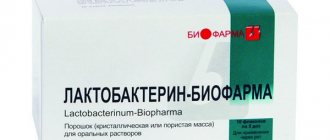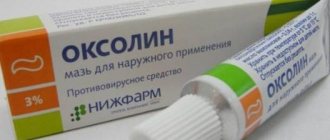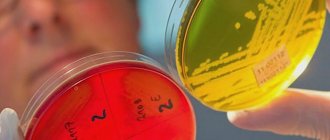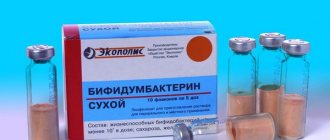The World Health Organization gave the official definition of probiotics only in 2002, although the existence and functions of beneficial microorganisms have been known for a long time. Probiotics are microbes that inhabit human organs and constitute their normal microflora.
Taking probiotics is justified if you need to eliminate pathogenic bacteria and restore normal conditions in the gastrointestinal tract. Probiotics for children are found in food products, and they can also be given in the form of dietary supplements or medications - the choice depends on the child’s condition, his age and other conditions.
What are probiotics and how are they different from prebiotics?
Probiotics are live microorganisms that make up the normal intestinal microflora. Beneficial bacteria are found in yogurt, kefir and other dairy products, which are often enriched with probiotics, for example, bifidokefir, ice cream with bifidobacteria, Actimel, etc.
Prebiotics are chemical compounds of organic origin that provide conditions for the proliferation of beneficial bacteria and inhibit pathogens. These substances are not absorbed by the mucous membranes; they act in the colon and stimulate the proliferation of microflora. Bread, cereals, onions, garlic, beans, corn, peas, and bananas are saturated with natural prebiotics. Products fortified with prebiotics always have this information on their labels.
"Lactobacterin" for newborns: instructions
Due to the fact that Lactobacterin is not a synthetic drug, its use for constipation in newborns is practically not accompanied by side effects. However, there is one exception to this rule - possible allergies.
Allergic reactions themselves are poorly predictable and can occur to anything, including bacteriocins secreted by lactobacilli, vitamins and enzymes.
Contraindications
The list of contraindications for taking the drug is also small. Thus, Lactobacterin for newborns is not indicated for use in the following two cases.
- With increased sensitivity of the body. This refers to both lactobacilli and auxiliary components of the drug. Among them are starch, a nutrient medium for bacteria (lactose monohydrate) and the bleaching agent of the mixture - titanium dioxide.
- For candidiasis of the mouth, vagina, intestines. The fact is that the acid-base balance is shifted to the acidic side. The displacement is very small. Nevertheless, it is enough to improve the living conditions of this fungus, since an acidic environment is favorable for it.
Forms and dosages of medicine
Before giving Lactobacterin to a child and diluting Lactobacterin for an infant, you need to familiarize yourself in detail with how the instructions for using the medicine recommend doing this. Depending on the age of the baby and the form of the drug, there are the following ways to take it.
- Pills. They need to be dissolved two or three times a day, half an hour before meals. A single dose for children under two years of age is two to three tablets, for children over two years of age - four to five tablets. The course of treatment is one week.
- Ampoules. It is recommended to dissolve Lactobacterin in ampoules for newborns in warm drinking water. But for this purpose, you can also use artificial milk formula diluted with water. The standard package contains ten bottles of five doses of the drug in each of them. Each such dose must be dissolved in one teaspoon of the selected liquid. The prepared solution must be taken immediately - it is not suitable for storage. This should be done half an hour before meals or a little more.
The rules for using the drug in ampoules are as follows:
- children under six months of age are prescribed two doses per day;
- children aged six months to one year - three doses per day;
- children from one to three years old - four doses per day;
- children over three years old - five doses per day.
This drug is not the only pharmaceutical concentrate of lactobacilli. It has analogues that may cost more, but many are cheaper.
- "Linex". Along with lactobacilli, it contains one of the types of lactic acid staphylococci.
- "Acipol." It has some kefir grains added to it.
- "Gastrofarm". In addition to lactobacilli, it contains protein that coats the walls of the stomach and intestines. This drug, unlike the previous ones, is used not so much to normalize the microflora, but as an antacid (due to the ability of lactobacilli to alkalize the environment in which they are found).
On the other hand, we must take into account that during the entire period of breastfeeding we only need Lactobacterin for newborns. In other words, populating a baby’s intestines with all the microflora at once is also harmful, because a significant part of it is not yet used for digestion. But it already releases its specific enzymes and other waste products into the intestinal cavity. This means that it is better to wait with many drugs containing foreign additives (fungi, rods, cocci), at least until the introduction of complementary foods.
Lactobacilli are one of the main components of normal intestinal microflora. It is these beneficial microorganisms that facilitate the digestion of nutrients in the child’s intestines. Since there is no microbial flora in the gastrointestinal tract of a newborn, pathogenic microorganisms may penetrate the mucous membrane or the presence of an insufficient number of normal microbial strains. In this case, lactobacilli are used as a component of complex treatment to restore the natural balance of intestinal microflora.
When should a child be prescribed probiotics?
The child’s digestive system finally develops only in the second year of life. The intestines are gradually populated by bifidobacteria and lactobacilli, but this process is almost always accompanied by minor troubles in the form of colic, disorders, and bloating. In older children, problems arise after taking antibiotics or due to poor nutrition.
To alleviate the child’s condition, the doctor prescribes medications or dietary supplements that help restore normal microflora, ensure food digestion and prevent harmful bacteria from multiplying. The positive influence of “friendly” microorganisms is expressed in good metabolism and a strong immune system.
Normal intestinal flora consists of:
- 90% bifidobacteria
- 8-10% enterococci, lactobacilli and non-pathogenic Escherichia coli
- 1% yeast-like fungi, Citrobacter, Proteus, Enterobacter, Staphylococcus and other microbes, harmless in balanced quantities.
If the proportion of beneficial microflora decreases, putrefactive fungi and other harmful microorganisms multiply in the intestines, disrupting digestion and metabolism.
Dysbacteriosis never occurs as an independent disease; it is always caused by a number of reasons - from unfavorable environment and poor nutrition to taking antibiotics.
In a child, dysbiosis manifests itself with the following symptoms:
- Pain and heaviness in the abdomen, flatulence and bloating
- Frequent constipation or diarrhea
- Poor digestion of food
- Belching, regurgitation in the smallest
- Skin irritation, peeling, diaper rash
- Bleeding gums
- Brittle nails and increased hair loss
- White or gray coating on the tongue, unpleasant odor in the exhaled air
- Appetite disturbance
It is important to make a correct diagnosis, since similar symptoms may be accompanied by other gastrointestinal disorders. After the examination, the doctor will rule out more serious diseases and prescribe a course of probiotic therapy. Preparations with probiotics cannot harm the baby, so they are included in many infant formulas.
Contraindications and side effects
Lactobacterin for newborns has few contraindications due to its natural composition. But few babies with individual sensitivity to the drug may develop allergic reactions such as urticaria:
- red spots and rashes in the form of small pimples appear on the skin;
- the child begins to be capricious due to sneezing and watery eyes.
Side effects from the gastrointestinal tract are extremely rare when consuming dilutions: nausea, vomiting, peristalsis disorders. Taking Lactobacterin should be stopped immediately and consult a pediatrician. In this case, no dose adjustment will be required - the drug will be replaced with drugs similar in therapeutic effect, for example, Bifidumbacterin.
Advice: If there is no improvement 2-3 days after starting treatment, you should make a second visit to the doctor to adjust the dosage or prescribe additional medications.
Also, contraindications for the use of lactobacilli for infants include the following pathologies:
- fungal infection caused by microscopic yeast-like fungi of the genus Candida;
- birth injuries of a certain origin.
Lactobacterin is not used in the treatment of increased gas formation in premature babies. The drug is used under the supervision of a physician in children with diseases of the liver and urinary system.
4 minutes Author: Anastasia Egorova 1714
Lactobacterin for newborns is a natural drug for the treatment of dysbiosis and other gastrointestinal disorders in babies. The child's body is very vulnerable to all kinds of influences, and most often it is the digestive system that suffers. The lactobacilli contained in this medicine effectively combat emerging problems, help restore intestinal microflora, and replenish the missing amount of bifidobacteria.
Release form
Pharmacists and biologists are actively developing new forms of drugs to restore microflora not only in the intestines. Beneficial flora is important for immunity in general, and for curing diseases that are accompanied by disruption of the normal bacterial background. Thus, probiotics in the form of suckable tablets will in the near future be used for the targeted elimination of foci of inflammation in the throat mucosa, for thrush and heartburn.
Currently, drugs are produced in liquid and dry form:
- Dry - powders, capsules and tablets. These are not the best forms, since the effectiveness of the substance decreases as the capsule shell dissolves and the powder dissolves. Some beneficial bacteria are removed from the body without having time to act.
- Liquid - their effectiveness is much higher, the bacteria are active and act immediately after taking the drug. For a child, liquid medications are the best option.
In addition, suppositories with probiotics are produced, but their effectiveness is very low, since paraffin interferes with the activity of bacteria.
Three groups of probiotics
Based on their origin, all probiotics are divided into three large groups:
- Bifidobacteria . They suppress the process of decay and normalize the microflora in the intestines; they are called orderlies. Preparations: Bifidumbacterin, Bifiform, Probifor
- Lactobacilli . Activate food digestion by converting lactose into lactic acid. Medicines: Acipol, Lactobacterin.
- Yeast-like fungi . Provide peristalsis and normalize stool. Medicines: Bactisubtil, Biosporin, Enterol.
Lacto- and bifidobacteria are found in breast milk and actively participate in the formation of the baby’s digestive system and his immunity. A bottle-fed baby should receive beneficial bacteria from modern milk formulas.
Single-component preparations belong to the first generation of probiotics. II generation drugs include spore bacilli and yeast-like fungi (Bactistatin, Sporobacterin). III generation symbiotics contain not only several bacteria, but also other useful additives (Linex, Acipol, Bifiform). The most modern IV generation drugs are synbiotics from several bacteria and components that activate reproduction (Probifor, Bifidumbacterin Forte, Florin Forte).
There are many drugs with probiotics in pharmacies; the main criterion when choosing is safety even with long-term use. Microorganisms of natural origin must be resistant to enzymes and bile and capable of rapid reproduction.
Bifidobacteria for newborns: reviews, prices and application
The most important thing for every mother is the health of her baby. If the baby is not in pain, he becomes joyful and cheerful, develops well, and eats with appetite.
Unfortunately, from time to time even a newborn baby, who is also less than a month old, begins to behave restlessly and show signs of malaise.
Having turned to the doctor, the parents will find out that the reason for the disgusting health of their baby is a lack of bifidobacteria in his gastrointestinal tract.
According to research by professionals, a child is born with a completely sterile intestinal tract. From the very first hours of a baby’s life, different microflora begin to appear in him.
If the baby’s health is in perfect order, he is breastfed and is protected from infection by various digestive infections, then the baby’s gastrointestinal tract is populated by certain types of bifidobacteria.
Bifidobacteria
Bifidobacteria are gram-positive rods with a curved shape. They are found in varying quantities in the gastrointestinal tract of infants, older children, and adults. With all this, not only the number of microbes differs, but also their species composition.
Bifidobacteria are needed even more for newborns than for an adult, whose gastrointestinal tract is dominated by lactobacilli. With all this, the types of microbes differ in children fed breast milk and babies who are bottle-fed.
Even the most excellent milk consistencies cause the growth of microflora in the baby’s intestinal tract, identical to the bifidobacteria that populate the body of an adult.
Bifidobacteria are of great importance for children. They improve the process of absorption of nutrients that enter the baby’s gastrointestinal tract along with food.
These beneficial tiny organisms convert the structure of proteins, fats and carbohydrates, ensuring the digestion of food. Bifidobacteria also have a beneficial effect on intestinal motility.
The average contraction of his muscles leads to the timely release of undigested food residues.
Bifidobacteria also play the role of a fighter against pathogenic microbes that cause various digestive diseases. This is very important for newborns, because their immune system is still quite weak and often cannot cope with even a small amount of harmful bacteria.
Bifidobacteria are of fundamental importance for ensuring the normal metabolic process. They produce lactic acid, which is necessary for the body to fully absorb iron, calcium, and vitamin D.
These substances are very necessary for the real physical and intellectual development of the baby, strengthening his immunity. Bifidobacteria also participate in the exchange of bilirubin.
This is very useful for children, because their pancreas, due to their age, does not work as smoothly as in an adult.
Bifidobacteria have antimutagenic properties, which are the basis for the prevention of cancer. These beneficial tiny organisms can also neutralize the effects of carcinogens.
Dysbacteriosis develops quite often in children. The risk group first includes children who are bottle-fed and receive other types of bifidobacteria. It is very important for newborns to be fed with mother’s milk at least initially, which contains all the necessary substances that ensure the growth of normal microflora.
Dysbacteriosis can develop due to severe digestive infections. Beneficial bifidobacteria can cope with a certain number of pathogenic microbes on their own, but if there are a lot of them or they are pathogens of dangerous diseases, then additional treatment is required.
Some pharmaceuticals, especially drugs, also suppress beneficial microflora, killing not only small pathogenic organisms, but also beneficial bifidobacteria.
A very premature start of complementary feeding without a preparatory discussion with the pediatrician has a negative impact on the state of the gastrointestinal microflora of children.
1. Problems with a chair. Children may experience constipation, diarrhea, and undigested snow-white lumps of food and mucus may be seen in the stool.
3. With prolonged dysbacteriosis, there is a decrease in the baby’s appetite; he does not gain enough weight.
4. Decreased immunity is a frequent companion to dysbiosis. At the same time, the child is at risk of falling ill not only from digestive infections, but also from serious respiratory diseases.
If your baby shows signs consistent with dysbiosis, you should consult a doctor. Without his advice, you should not give your baby bifidobacteria for newborns, reviews of which turned out to be more good.
The pediatrician will conduct the necessary examinations to make an accurate diagnosis. Often, even more severe diseases occur under the guise of dysbiosis, such as serious digestive infections, allergies, and differences in the structure of the gastrointestinal tract.
If dysbiosis is indeed confirmed, the doctor will prescribe special medications to the child that normalize the microflora of the intestinal tract. He will also give the baby's parents advice on proper nutrition that the child should follow.
If you follow all the doctor’s instructions and choose a product that is more suitable for the baby, then the healing efficiency will be the highest.
All drugs that normalize microflora can be divided into probiotics and prebiotics. Prebiotics are carbohydrates that are not digested by the body, but serve as a medium for the growth of necessary microbes. Probiotics are lacto- and bifidobacteria that are presented in the preparation independently or are included in the composition of some other product.
Of all the drugs containing bifidobacteria that are more suitable for newborns, the cost of which is affordable to virtually all parents, Bifidumbacterin and Linex are most often prescribed.
Their price ranges from 200 to 500 rubles, depending on the dose of the medicine, the presence of additional components, for example activated carbon, and the number of capsules in the package. These medications are effective and comfortable to use. The drugs are usually mixed with milk consistency, complementary foods, and water.
In order for the medicine to remain effective, it is important to follow the instructions for its storage indicated in the annotation for the medicine. Preparations containing bifidobacteria are usually stored in the refrigerator.
Drugs with a more effective effect, which are prescribed as accompanying main medications in the fight against digestive infections, are bacteriophages.
These medicines come in a watery form and have huge concentrations of different bifidobacteria created to neutralize certain types of pathogenic microbes.
Their price is higher than that of more conventional drugs; it ranges from 500 to 1000 rubles.
Apart from special pharmaceuticals, which are based on useful tiny organisms, there are also ordinary food products with their addition. Infant formula with bifidobacteria will help restore normal microflora to a baby who needs to switch to artificial feeding.
Children's cereals and yoghurts are also enriched with bifidobacteria. To ensure that the presence of these microbes in a product is greatest, it is necessary to focus on its shelf life. By the time it ends, fewer bifidobacteria remain in the food.
How do they work?
Probiotics are designed to temporarily colonize microorganisms in the intestines. After eliminating dysbacteriosis, they are eliminated from the body.
The mechanism of action is as follows:
- Through the digestive tract, probiotics enter the large intestine.
- A protective membrane is formed on the intestinal walls, preventing the spread of harmful bacteria.
- Pathogenic flora dies, and favorable conditions are created for the development of beneficial microorganisms.
- Thanks to probiotics, food is well digested and the body effectively absorbs proteins and other beneficial substances.
The dose of the drug and the duration of the course are determined by the doctor. The amount of the drug largely depends on the age of the child, but usually one dose per day is enough. A tangible result will appear with systematic use.
The importance of good gastrointestinal functionality
In order for the baby to be strong, strong and, most importantly, healthy, it is necessary to initially train the gastrointestinal tract to function correctly. The main causes of disease are directly related to intermittent food processing, resulting in vitamin deficiency. Microorganisms are inactive, harmful ones are off the charts, and the result is dysbacteriosis.
A lack of nutritional components in the body leads to a complete loss of energy, a disgusting mood, and poor health. From an early age, it is necessary to form a productive filling of the gastrointestinal tract, with protection from colic.
“Invisible bodies” that enter the gastrointestinal tract create a settlement, preventing harmful ones, wrapping the area in a defensive shell, and in addition promoting the functioning of the intestinal walls. Thanks to the work of the “right” organisms, nerve endings are formed, and the tiny intestines are able to accept new nutritional supplements. Periodically, the intestines receive juices, purees, porridge, it is important to process new food elements diligently. A deficiency of beneficial microorganisms leads to lightning-fast bloating and prickly cramps. In order not to trigger such situations, it is necessary from the first days to fill the small intestines with useful representatives of the biota that help development. If the gastrointestinal tract did not receive the necessary element in childhood, defective intestinal functioning will continue in adulthood.
Probiotics for children of the first year of life
Bacteria colonize the newborn's intestines in the first days after birth. Along with breast milk, the baby receives a set of microflora; if the child eats only breast milk, additional probiotics are not needed. Sometimes harmful bacteria still prevail and then the baby experiences frequent colic and a bloated tummy. But the troubles are not limited to this - due to poor absorption of substances, immunity decreases, the child gets sick more often. In such cases, taking probiotics is justified.
If there is little milk or the child has already been switched to complementary feeding, digestion works under load and the help of beneficial bacteria is very often needed. For children in the first year of life, liquid preparations are recommended, which are diluted with breast milk, infant formula or water.
Formula-fed babies can only get beneficial bacteria from formulas with probiotics. Information about their availability is always on the packaging of baby food, which is allowed from the first days of life. Such mixtures are better absorbed and normalize digestion.
Even if there is a shortage or absence of breast milk, you should not replace it with cow or goat milk. The arguments of grandmothers and their stories about how entire generations grew up on semolina porridge and milk from a trusted cow, beautiful tales about the banks of jelly. Without delving into history, let us take into account that babies screaming all night long were a common occurrence 50 years ago. Children fed with a “life-giving natural product” have already forgiven the torment, and our babies have the opportunity to suffer less from colic.
Cow's milk is contraindicated for children in the first year of life - it disrupts the microflora and can cause allergies due to the high lactose content.
For children under one year of age, preparations without cow's protein and lactose have been developed:
- Bifiform Baby
- Normoflorin-L and Normoflorin-B
- Narine
- Liveo Baby
Instructions for use
Before starting to use Lactobacterin for the treatment of colic and bloating, a consultation with a pediatrician is necessary, regardless of whether the child has previously taken the drug or not. The doctor will examine the baby, assess his general health and give recommendations on the duration of the course of treatment.
Lactobacterin is indicated for use by newborns only in the form of a solution. The pharmacological drug can be diluted with water, breast milk, and infant formula. Single and daily doses are determined by the pediatrician depending on the age and weight of the child. The results of laboratory tests and the diagnosed disease are of no small importance.
Advice: Lactobacterin is often prescribed as a prophylactic agent during treatment with various drugs, especially those with antibacterial properties. In this case, pediatricians recommend a single dose of the solution for 7-10 days.
Dry lyophilisate should be dissolved only in warm water. Under the influence of high temperature, beneficial microorganisms will die and the therapeutic effect will be reduced to zero. Lactobacterin solution for newborns according to the instructions is prepared as follows:
- in a separate container or directly in the bottle, dilute a dose of the drug with 5 ml of liquid;
- shake the mixture well until the lyophilisate is completely dissolved;
- Give the baby a drink from a spoon or add the dilution to a water bottle.
The optimal time to use Lactobacterin solution is 30-60 minutes before feeding. The dilution must be freshly prepared; it cannot be left even for 2-3 hours in the refrigerator, and especially at room temperature due to the high probability of contamination with pathogenic microorganisms:
- staphylococci;
- streptococci;
- mold fungi.
For better absorption of beneficial bacteria in the baby’s intestines, a sufficient amount of vitamins is necessary. A nursing mother should include in her diet foods enriched with these biologically active substances and mineral compounds - cereal porridge, fresh vegetables, cottage cheese.
Probiotics after a course of antibiotics
The principle of action of antibiotics is to suppress the growth and reproduction of bacteria, while beneficial microorganisms are also destroyed along with pathogenic ones. Treatment with antibiotics is sometimes necessary, but after a course, intestinal dysbiosis very often occurs. The beneficial microflora suffers, and as a result, along with recovery, indigestion, colic, and flatulence occur. Preventive intake of probiotics and prebiotics allows you to avoid such consequences.
- Hilak Forte and Pikovit Prebiotic . Pediatricians recommend prebiotics with substances that remove pathogenic microorganisms for children of any age. After cleansing the intestines, beneficial microflora can develop freely.
- Linux . An effective probiotic with lacto- and bifidobacteria, and enterococci, destroys pathogenic bacteria and normalizes the intestinal microflora.
- Liveo . Probiotic with four strains of beneficial bacteria.
During the course of antibiotics and after it, it is necessary to adjust the child’s diet. The baby will recover faster if he eats natural fruits and vegetables, fresh juices and dishes with fiber. Fatty and carbohydrate-rich foods burden the body and do not create conditions for the restoration of normal microflora in the intestines.
The doctor will decide which probiotics, prebiotics or complex synbiotics are suitable for the baby, usually taking 3-4 weeks.
Directions for use, recommended dosage
It is given from the first days of babies’ lives.
One package with meals. The contents must first be diluted in juice, tea, milk, infant formula, and water. Course – 10-14 days.
For preventive purposes or during the eruption of baby teeth, a prebiotic is given for one week.
When treated with antibiotics, the nutritional supplement is taken immediately. Before traveling, changing your place of residence, or starting to attend kindergarten, admission should begin two weeks before the upcoming events.
On the topic: diet for childhood dysbiosis.
Best Children's Probiotics
Pediatricians do not have difficulty choosing suitable medications for dysbiosis. There are many drugs in pharmacies, time-tested and new; there are inexpensive and effective probiotics from domestic and foreign manufacturers.
Names and brief descriptions of the most popular probiotics for children:
| Description | Characteristic |
| Linex | Drops, powder or capsules of combined action. Prescribed as a preventive and therapeutic agent for dysbiosis in children of any age and adults. Linex has proven itself well; the liquid preparation is especially effective, acting faster than tablets and powders. |
| Hilak-forte | A reliable drug, after a course of antibiotics Hilak-Forte is considered the best remedy. |
| Bifiform | Available in the form of capsules, powder, drops, chewable tablets. Helps cope with gastrointestinal disorders and restore the bacterial background. |
| Bactisubtil | Capsules are suitable for children from 5 years of age. Before this, it can be given for dysbiosis and intestinal infections after dissolving the contents of the capsules in water, milk or other liquid. |
| Trilact | Drops with lactobacilli are indicated for children of the first year of life for constipation, flatulence and allergies. |
| Probifor | Powder with bifidobacteria can be given to children from birth. |
| Enterol | It is available in the form of capsules and powders, but for children after one year it is better to give the medicine in powders. In addition to restoring microflora, Enterol helps cope with diarrhea, intestinal irritation and colitis. The main component is fungi of the Saccharomyces class, which have the ability to collect and suppress pathogenic bacteria. |
Description of the drug Bifidumbacterin
Medicines are allowed to be given to newborns only for medical reasons. However, parents should know the list of effective drugs with bifidobacteria and lactobacilli:
- Simbiter-M for children is a drug with live lacto- and bifidobacteria. The dosage form is a powder that is mixed with breast milk or water. The drug is resistant to the effects of gastric and pancreatic juice, and therefore normalizes the microflora of the oral cavity, stomach, and intestines. Recommended for use by newborns from 1 month to 3 years.
- Hilak Forte normalizes the natural bacterial flora and eliminates flatulence. This drug is used to prevent dysbiosis after treatment with antibiotics. The drug contains metabolites of lactobacilli, streptococci and Escherichia coli. Hilak Forte is used from birth.
- Narine is a dietary supplement based on lactobacilli. In essence, it is a starter from which a fermented milk drink is prepared. The product is intended for children from 5 days of life.
- BioGaia in the form of drops is prescribed from birth. Lactobacilli for newborns are prescribed for colic and difficult stool ejection. Use with caution in diabetes mellitus and kidney dysfunction. It is most often used to treat bottle-fed infants.
- Bifidum-multi1 is a drug based on bifidobacteria that restores the natural bacterial flora and prevents dysbacteriosis. The medicine can be mixed with milk or formula. Suitable for children from birth to 3 years.
- Bifiform Baby is a dietary supplement containing bifidobacteria and streptococci. The probiotic preparation normalizes the intestinal bacterial flora. Dietary supplements are prescribed to children from birth to 2 years.
- Linex with bifidobacteria, lactobacilli and enterococci is allowed to be used from birth. Available in the form of capsules with powder inside. Before use, the capsule is opened and the powder is mixed with milk, formula or water.
- Acipol with lactobacilli and kefir grains eliminates harmful bacteria from the newborn’s body and strengthens the immune system. The drug is intended for infants from 3 months to 3 years. Available in capsule form, it is used in the same way as Linex.
- Biovestin with Bifidobacterium adolescentis. Available in the form of an emulsion for oral administration. Designed for newborns from the first days of life.
Before using medications, you should consult a doctor.
Bifidumbacterin is a probiotic (a product containing live cultures of lacto- and bifidobacteria). It is not a drug, but rather serves as a dietary supplement.
It has a fairly good effect in the treatment of dysbacteriosis, populating the intestines with beneficial bacteria, which, in the process of reproduction, form a healthy microflora in it, displacing pathogenic organisms.
In addition, the product normalizes metabolic processes and digestive functions, activates the immune system, and promotes better absorption of nutrients.
There are several types of the drug:
- Bifidumbacterin.
- Bifidumbacterin Forte.
- Bifidumbacterin Multi (1, 2 or 3).
- Bifidumbacterin 1000.
Bifidumbacterin Forte - a drug to relieve symptoms of intestinal dysfunction in infants
Bifidumbacterin is produced in several forms, containing the same active substance - freeze-dried microbial cells of living bifidobacteria of the antagonistically active strain Bifidobacterium bifidum N1, purified from the cultivation medium. Each product has a different dosage. In addition, the medicine contains various auxiliary components depending on the form:
- Capsules. Lactose or lactulose are excipients. The capsule itself consists of formative gelatin, titanium dioxide and indigofarmin. Bifidumbacterin, Bifidumbacterin Forte and Bifidumbacterin Multi (2 and 3) are produced in this form.
- Pills. Excipient: lactose. Bifidumbacterin and Bifidumbacterin 1000 are produced.
- Lyophilisate for preparing a solution. Auxiliary components are sucrose, gelatin and skimmed milk powder. Only Bifidumbacterin is produced in this form.
- Powder in bags and bottles. An auxiliary component is lactose (which is found in milk). Bifidumbacterin Forte and Bifidumbacterin Multi (1 and 2) are presented in this form.
- Liquid emulsion. Excipients: gelatin, lactose or sucrose and skim milk. Bifidumbacterin is produced in this form.
- Suppositories (candles). Auxiliary components are hard or confectionery fat, petroleum paraffin, lactose, sucrose-gelatin drying medium and T-2 emulsifier. Bifidumbacterin is produced.
Newborns and infants are advised to use Bifidumbacterin and Bifidumbacterin Forte in powder and liquid forms, as well as in the form of lyophilisate (due to the ease of their use).
Bifidumbacterin Forte differs from simple Bifidumbacterin in that a sorbent (activated carbon) is added to its composition, which promotes the uniform distribution of bacteria throughout the intestine and the removal of pathogenic flora and toxins.
Bifidumbacterin: dry powder in bags Bifidumbacterin: lyophilisate for preparing a suspension in ampoules Bifidumbacterin: liquid emulsion, easy to use
When can a pediatrician prescribe Bifidumbacterin for a baby?
Bifidumbacterin will help with tummy problems in your baby
The drug is prescribed for:
- dysbacteriosis;
- intestinal infections (salmonellosis, dysentery, escherichiosis, viral infections, etc.);
- diarrheal syndrome of staphylococcal and unknown etiology;
- diarrhea;
- constipation;
- colic;
- frequent regurgitation;
- vomiting;
- increased gas formation and bloating;
- enzyme deficiency;
- general purulent infectious diseases;
- frequent illnesses;
- in order to boost immunity;
- to populate the intestines with beneficial microflora in babies born prematurely;
- to normalize the intestinal function of bottle-fed babies;
- in the complex treatment of diseases such as rickets, anemia, malnutrition, various manifestations of allergies;
- in case of disruption of normal intestinal function while taking antibacterial drugs during the neonatal period.
Bifidumbacterin is considered a safe drug, therefore it is approved for use from the first days of a baby’s life. It has no contraindications, and no side effects are observed as a result of taking it.
It is worth noting that Bifidumbacterin should be taken with caution by those who have lactase deficiency (milk intolerance), since it contains lactose and lactulose, which are milk sugars. In this case, not always, but dyspeptic symptoms may develop in the form of nausea, regurgitation and vomiting, which quickly disappear when the drug is discontinued.
Interaction with other drugs, as stated in the instructions for the drug, has not been established. No negative effects are observed when taken simultaneously.
Moreover, Bifidumbacterin has a positive effect on the gastrointestinal tract when using antibacterial drugs, antivirals, immunomodulators, which negatively affect the intestinal microflora.
The dose, form and duration of taking the drug are determined by the pediatrician. The duration and effect of the course depend on the general condition of the child’s body, as well as on the state of the intestinal microflora.
On average, treatment with Bifidumbacterin lasts no more than two weeks, but in case of severe or chronic dysbiosis, the course is extended to four to five weeks.
It is convenient to give Bifidumbacterin through a bottle, dissolving it in warm water, breast milk or formula
For newborns, the drug in the form of a concentrated liquid emulsion should be mixed with a small amount of warm boiled water (no more than forty degrees), breast milk or formula, given to the child, and then watered and fed to the baby as usual. Some mothers whose children are able to drink from a spoon give Bifidumbacterin this way or pour the diluted drug from a syringe into the cheek. Shake the bottle before use.
The dry powder from the bag must be poured into a container with breast milk, water or formula, stirred thoroughly until dissolved (a cloudy suspension should form) and given to the baby. Breeding is done before feeding.
When using a lyophilisate, do the same thing, only the liquid is added directly to the bottle and shaken.
There is no need to prepare the product in advance, since after standing for some time, it loses its properties.
The drug is diluted in 30 ml (about 3 tablespoons) of warm liquid until a cloudy suspension forms. It is given to the child at the beginning of feeding in a separate bottle, after which it is necessary to give breast or another bottle with the mixture in the required quantity.
Bifidumbacterin can be replaced with any other probiotic preparation suitable for children during the neonatal period. Only your pediatrician can tell you which product is allowed to be used specifically for your child in a given situation.
Lactobacterin is an inexpensive probiotic that has a positive effect on the functioning of the intestines Acipol will help with constipation and diarrhea Linex contains a complex of bacteria that restore the intestinal microflora Probifor is excellent for helping with diarrhea and poisoning
To this day, doctors have differing opinions about the benefits of some probiotics. Some believe that they help in the development of the intestinal function of the newborn, while others are of the opinion that as the child grows, the intestines itself adapt to all conditions, so help is not needed.
In general, reviews of the drug Bifidumbacterin are positive. But any specialist will tell you that you shouldn’t mindlessly take it “for all your ailments.” Moreover, there is no need to use it in the absence of symptoms of intestinal disorders.
Bifidumbacterin, like probiotics in general, cannot be considered a panacea for all intestinal disorders. Only a doctor can determine the causes of the baby’s anxiety and prescribe him the necessary medication, suitable in a given situation according to his age and weight.
The composition of the product includes a dry microbial mass containing live bifidobacteria (that is, those bacteria that are part of the intestinal microflora in a normal state), as well as a bifidogenic factor (one that promotes the growth of bifidobacteria) lactose (a disaccharide found in milk). The composition of the drug (1 dose) includes at least 107 CFU of lyophilized bifidobacteria.
Release form
Possible harm
If you violate the rules for taking probiotics, side effects cannot be ruled out. Children may have individual intolerance to drugs and their components, as well as allergic reactions. More often, allergies occur when consuming liquid probiotics and medications containing spore-forming bacteria and yeast. In addition, undesirable reactions are observed with abrupt withdrawal after a long course of probiotics. Pathogenic bacteria are activated when beneficial microflora does not come from outside.
Observe the dosage and adhere to the established regimen for taking the drug, use medications intended for children of a certain age to minimize the risk of complications. Be sure to consider the expiration date of probiotics.
Direct contraindications to the use of probiotics are limited to the individual characteristics of the body, immunodeficiency states, and cancer. In other cases, taking the prescribed drug is harmless and cannot harm the baby.
Click Share and make your friends happy!











